The Horror! The Horror!: Comic Books the Government Didn't Want You to Read!
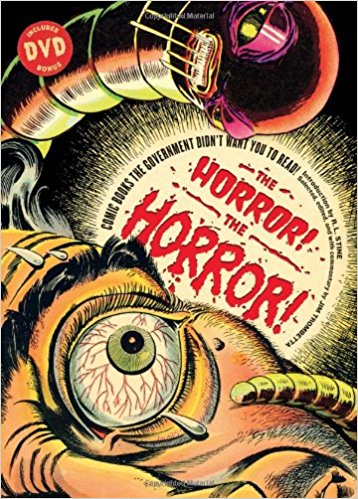 When the Comics Magazine Association of America established the Comics Code in 1954, non simply was salacious, suggestive, fierce and horrific content banished from comic books but an entire industry was decimated. This self regulating body, which operated under political and commercial interests, came into effect following the widespread panic that America's youth were on a crash class to delinquency on account of comic books. Comic books were not particularly new, only certain themes in the comic books were, and they proved enormously popular with young readers. Titles such as Chamber of Chills, Horrific, Startling Terror, Blackness True cat and Worlds of Fright were devoted to supernatural and horror themes, while, beneath every bit spectacular and tasteless comprehend art, Criminal offence Does Not Pay, Police Breakers Suspense Stories, Law-Crime and Crimes by Women covered the gun toting mobsters and their leggy molls.
When the Comics Magazine Association of America established the Comics Code in 1954, non simply was salacious, suggestive, fierce and horrific content banished from comic books but an entire industry was decimated. This self regulating body, which operated under political and commercial interests, came into effect following the widespread panic that America's youth were on a crash class to delinquency on account of comic books. Comic books were not particularly new, only certain themes in the comic books were, and they proved enormously popular with young readers. Titles such as Chamber of Chills, Horrific, Startling Terror, Blackness True cat and Worlds of Fright were devoted to supernatural and horror themes, while, beneath every bit spectacular and tasteless comprehend art, Criminal offence Does Not Pay, Police Breakers Suspense Stories, Law-Crime and Crimes by Women covered the gun toting mobsters and their leggy molls.
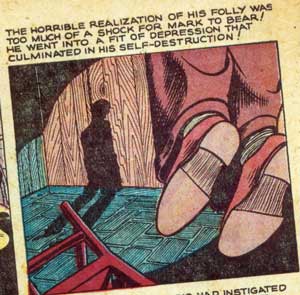
Fired upward by the media, America panicked and communities all over the country reacted by holding comic book bonfires, encouraging their children to give up their comics and fire them. Information technology was a scene no intelligent society should tolerate, but the volume burning pyres of Deutschland a few years earlier had conspicuously dissipated with the baying for fresh claret.
The comic companies that produced horror and crime titles—which was most of them—had turned the novelty of the comic book into a nationwide commercial phenomenon, and the comics themselves a major new art form, as unique to American culture as jazz music. Then, overnight, all but a scattering of the comics and publishers were gone.
Lately there has been a resurgence of interest in comic books of the 1950s, specifically the horror and offense comics that for and so long were the ugly progeny of the comic book industry. This resurgence coincides with the growth of the then-called 'graphic novel' as a legitimate literary class, just is actually more than a reaction to it than a product of it: Legitimate and practiced fine art is rarely interesting, little wonder that some people should seek out other forms of it.
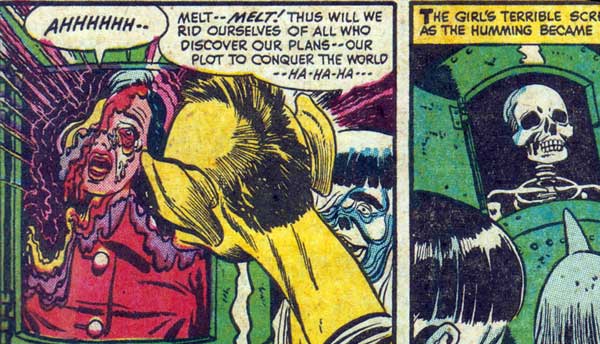
EC Comics also helped to shape this resurgence; their key titles Tales from the Crypt, The Vault of Horror and The Haunt of Fear, and highly talented team of artists, have come to epitomise what fifties horror comics are all about. EC publisher Bill Gaines fifty-fifty represented the maligned medium during the Senate Subcommittee on Juvenile Delinquency in spring 1954. (He belly-flopped.) Simply EC is non even half of the story, but one publisher among the many that turned out hundreds of comic titles every month. Ace, Prize, Harvey, Avon, ACG, Ajax-Farrell, Star, Fawcett, Ziff-Davis, Atlas and Story are but a few of the other publishers.
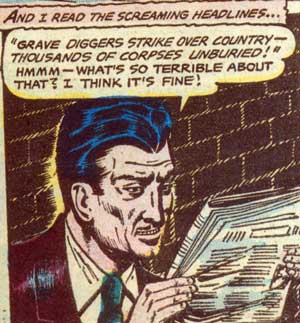
Until recently, the greater history of the comic book was lost amid the frequent reprints of EC titles, the many administrative books dedicated to EC, and the prestige of EC movie and goggle box offshoots. Other comic publishers of the twenty-four hour period were largely exiled from comics history or simply regarded as lowly rip-off merchants, their stories considered to be badly executed facsimiles of the EC fashion.
Having exhausted EC through the reprints, it was a surprise to discover the many other companies churning out agreeing textile in the fifties. My education on the discipline, and daresay that of many other people, too, was a series of magazines called Tales Also Terrible To Tell (aka Terrology).
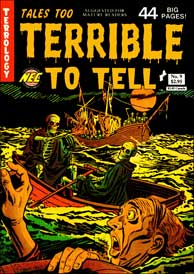
Published by NEC, Tales Too Terrible To Tell start appeared in 1989/1990 and, for xi problems, sought to redress the EC monopoly past reprinting horror strips published by these other companies. The mag was relatively low upkeep, reproducing strips that were originally in colour on b&due west lurid stock, simply this in many ways suited the apprehensive content and heightened its appeal. Along with the reprints, each effect carried an informed history of pre-code comics and publishers that was written past editor George Suarez. Tales Too Terrible To Tell was fresh data and an inspiration for time to come collectors.
Tales Too Terrible To Tell ran until 1993, when, along with its short-lived companion titles, Extinct! and Anti-Hitler Comics, the magazine folded without adieu. By this time, however, interest in pre-code horror and criminal offense comics was buoyant enough for other works on the discipline, such as Mike Benton'south lavish book serial, History of Comics, published by Taylor in 1993. Volumes one and v embrace horror and crime, and while this coverage includes some modern comics, the series is indebted to early on titles.
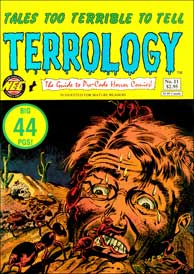
At this juncture information technology'due south off-white to comment on another volume, Martin Barker's A Haunt of Fears, published by Pluto in 1984. It is possibly the first book devoted to the controversy surrounding comic books of the 1950s, albeit from a purely British perspective. It'southward fitting that Barker should have written it; that aforementioned twelvemonth, Barker edited The Video Nasties (also Pluto, 1984), the starting time volume to examine the controversy over videos as information technology was raging in United kingdom at the time. Both the comics and video campaigns run a frightfully similar course, from a witch-hunt to a clampdown, past way of an ambiguous piece of legislation (a Comics Code and a Video Recording Deed) that clears the playing field to the benefit of the bigger companies.
So we arrive at The Horror! The Horror! Comic Books the Government Didn't Want You To Read! This hefty, oversized book uses isolated pages and panels from horror comics of the 1950s, along with a few key strips, to tell what might seem by now a familiar story. But author Jim Trombetta has an arresting accept on it, one that readers will applaud and probably express joy at in equal measures.
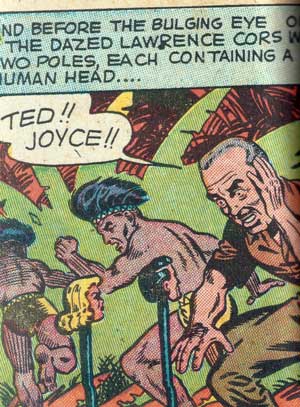
Jim Trombetta is noted in the biographical blurb as a Shakespearean scholar, a reporter and editor for Crawdaddy, the Los Angeles Times, and other publications. He is likewise a writer on Idiot box shows, including Miami Vice, The Flash and Star Expedition. The blurb says zippo of him being a psychoanalyst, just in this book he acts as one, picking through sometime comic books with an annotator's eye. This is more fun than it might sound, and it strikes some interesting chords.
The chapters are relatively brusk, with the text for each lasting no more than a page or two. The emphasis is on the artwork and strips, and in this respect the volume'due south blueprint, past Jacob Covey, is every bit as important as the words of Trombetta. (The reproduction of comic strips in The Horror! The Horror! is tiptop class: The stock is yellowish for a decayed comic volume await, and the colours and contrast muted.) Trombetta observes the typical concerns of an era living under the threat of nuclear Armageddon, and applies it to his discussion, just then his accent is on some unusual minutiae inherent in the comics, such as that of a disembodied leg that appears on one cover from 1953.
The cover in question, past Howdy Fleishman, graces Night Mysteries issue thirteen (Baronial 1953), and it features in a affiliate chosen Tom's Leg. Fleishman'southward artwork depicts a prison yard, where several inmates follow the startled gaze of a warden towards a dismembered leg standing in a corner. The residual of the body is missing. "Information technology's Tom's leg," exclaims the warden, "but he was executed final dark!" Overseeing the macabre scene through the confined of a nearby prison cell is a skeleton.
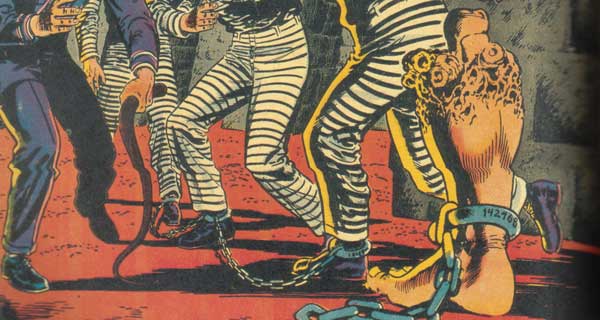
Trombetta'south considerations are worthy of note. 'The image invokes several horror myths,' he writes,
offense and punishment, dismemberment, cannibalism, living dead—without establishing any real human relationship between them. It is supersaturated with dream imagery that refuses to fit together, from Tom's leg to the guard'due south snakelike pissle to the skeleton on the right clutching the iron bars of the closet size cell…
The fact that none of the to a higher place elements fit is fundamental to the appeal of the pre-code comics, Trombetta determines. Tom'due south leg is unadulterated nightmare, with no rhyme or reason. It's a picayune silly, but that in itself is nightmarish. Trombetta goes on:
Equally with many horror comics covers, at that place is no coherent history that could take produced the outcome we see on Night Mysteries number thirteen. Likewise, while the embrace is genuinely ominous, it is hard to imagine what could perhaps happen next. Perhaps the guard and prisoners will break into a trip the light fantastic toe routine from Jailhouse Rock…
Trombetta draws on literary theorist Northrop Frye in his lead to describing this cover, with references to iconic modes and whatnot. Comic artists of the 1950s were paid a lowly, standard fee. They were probably non overly aware and even less bothered by what they were conveying, outside the fact information technology was a job, and they were making horrible images for horror comics. Perhaps this itself is some kind of exorcism of the hidden? In our more enlightened times, comics and comic characters require some semblance of a dorsum story, and Tom's leg would no uncertainty suffer a postmodern take that drives the reader forward on the pretext some sense will come of it all. Hi Fleishman does non offer whatsoever such comfort with Tom's leg. It is what it is.
schumanwhimen1991.blogspot.com
Source: https://headpress.com/the-horror-the-horror-comic-books-the-government-didnt-want-you-to-read/
0 Response to "The Horror! The Horror!: Comic Books the Government Didn't Want You to Read!"
Post a Comment